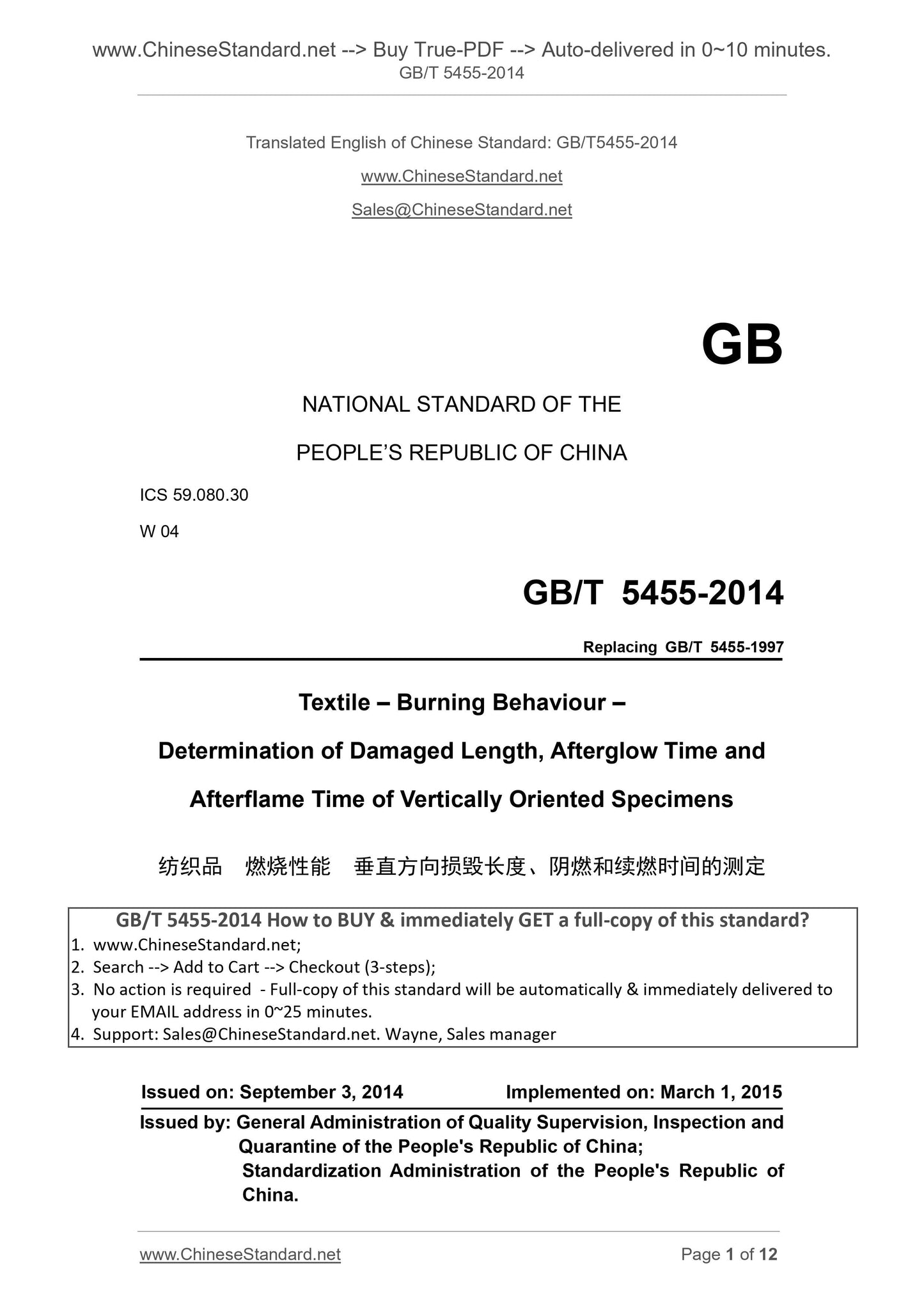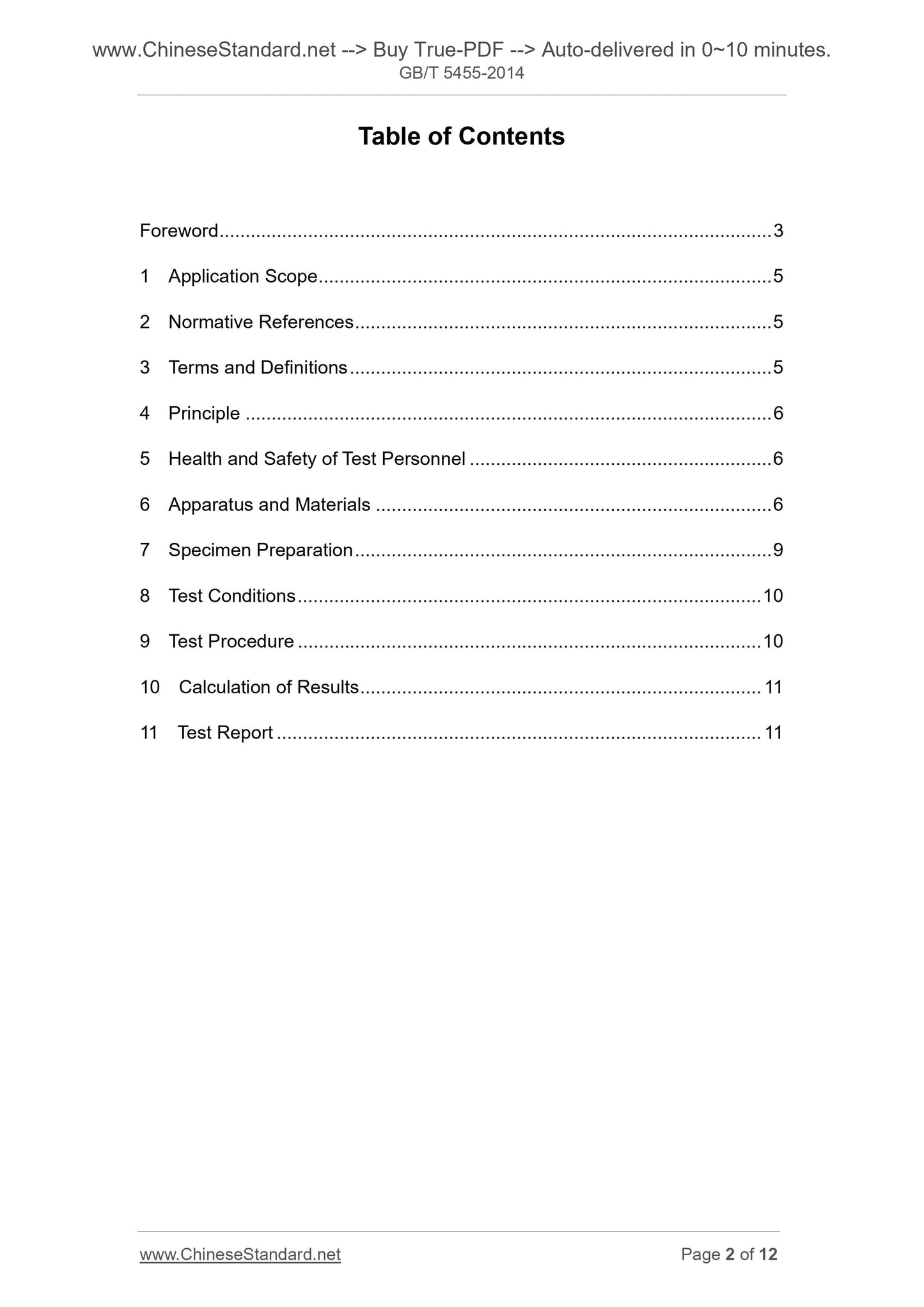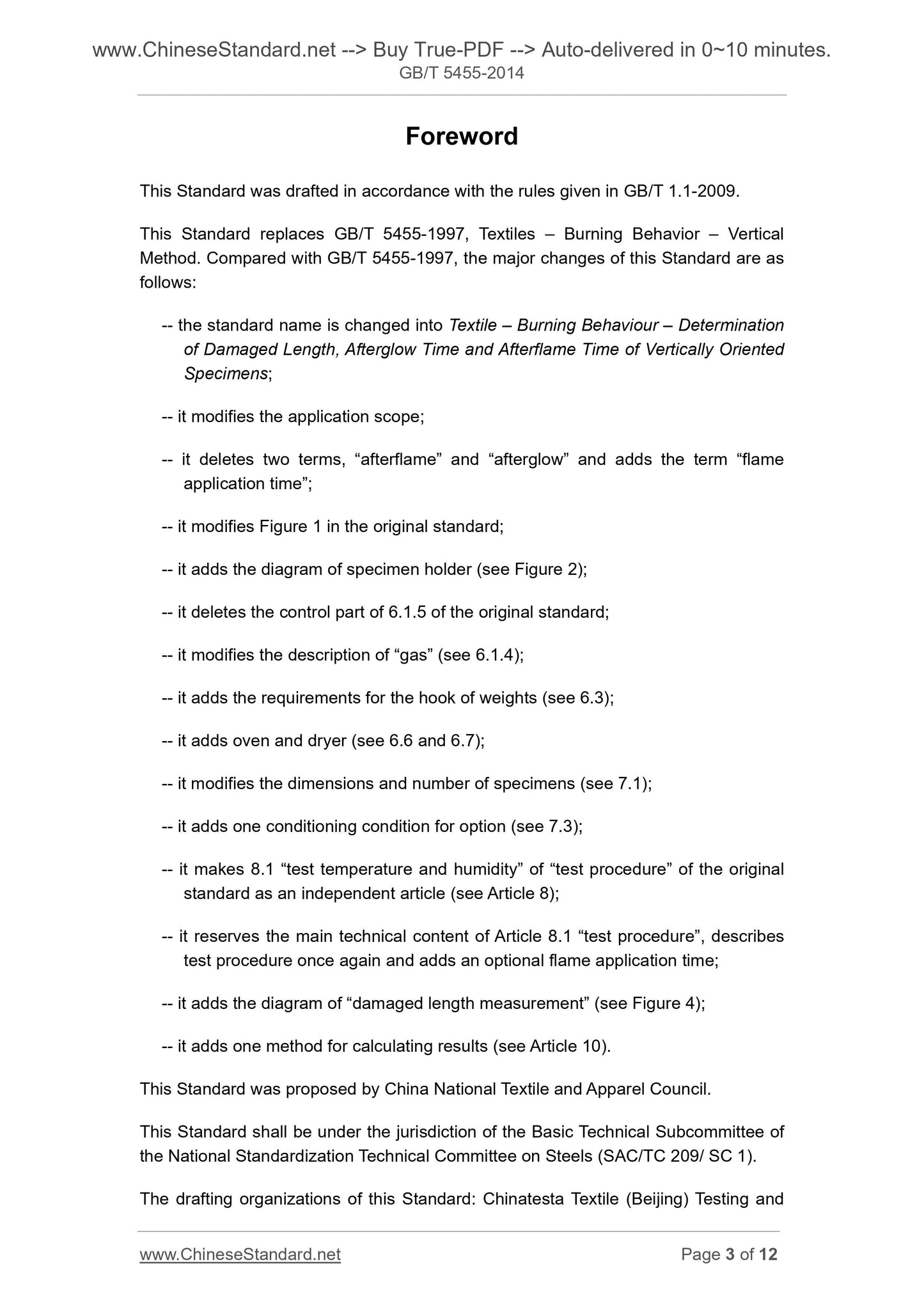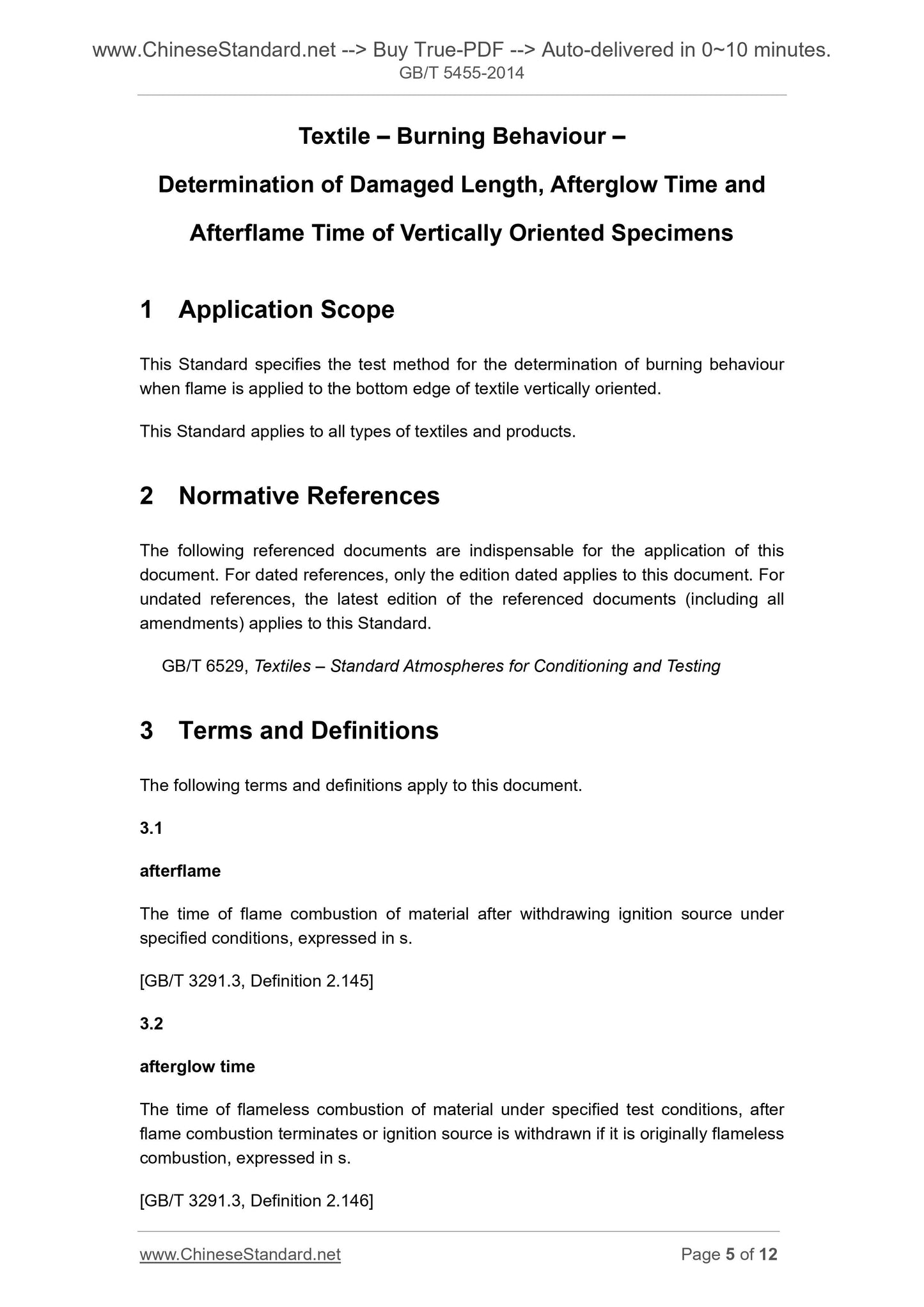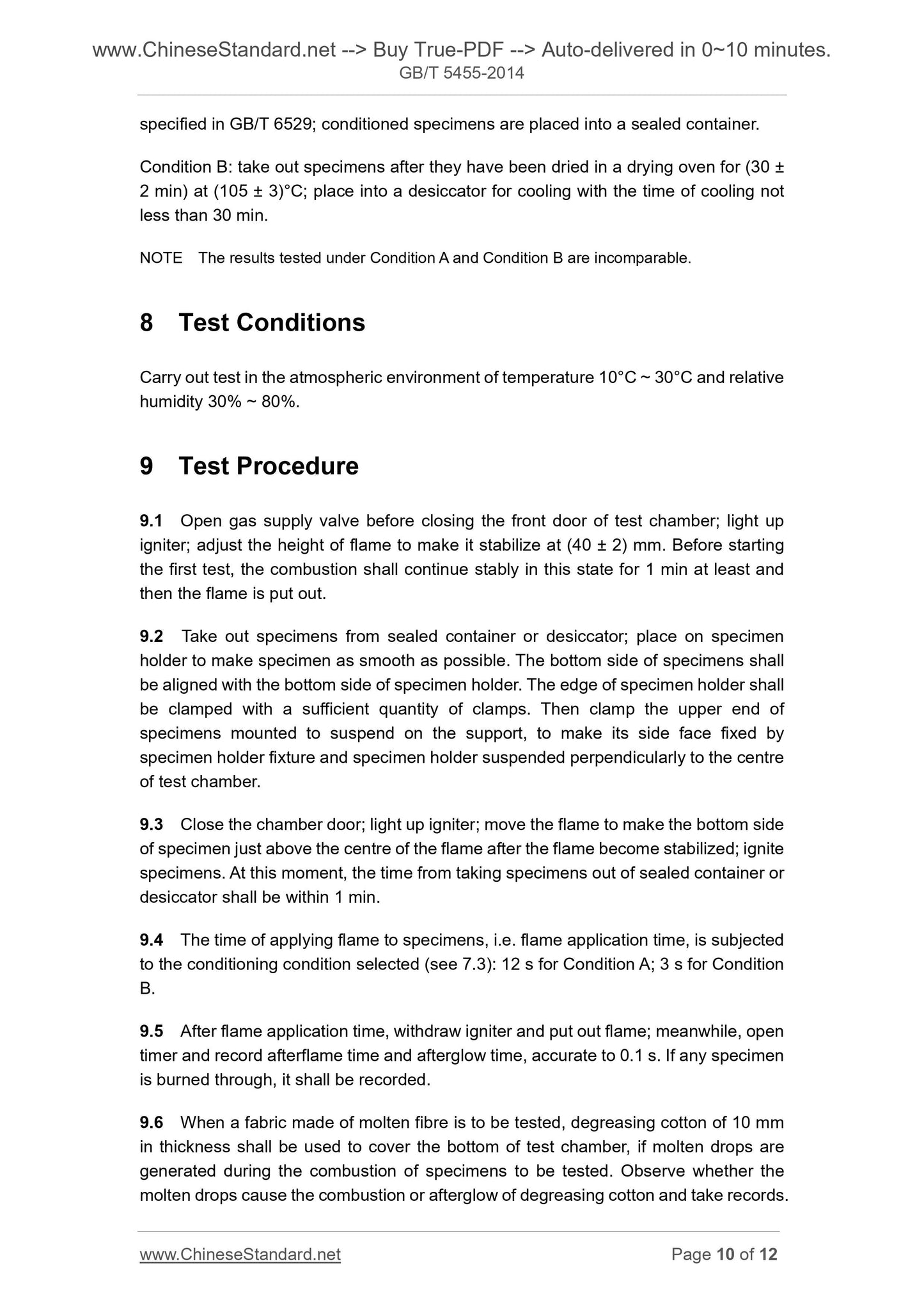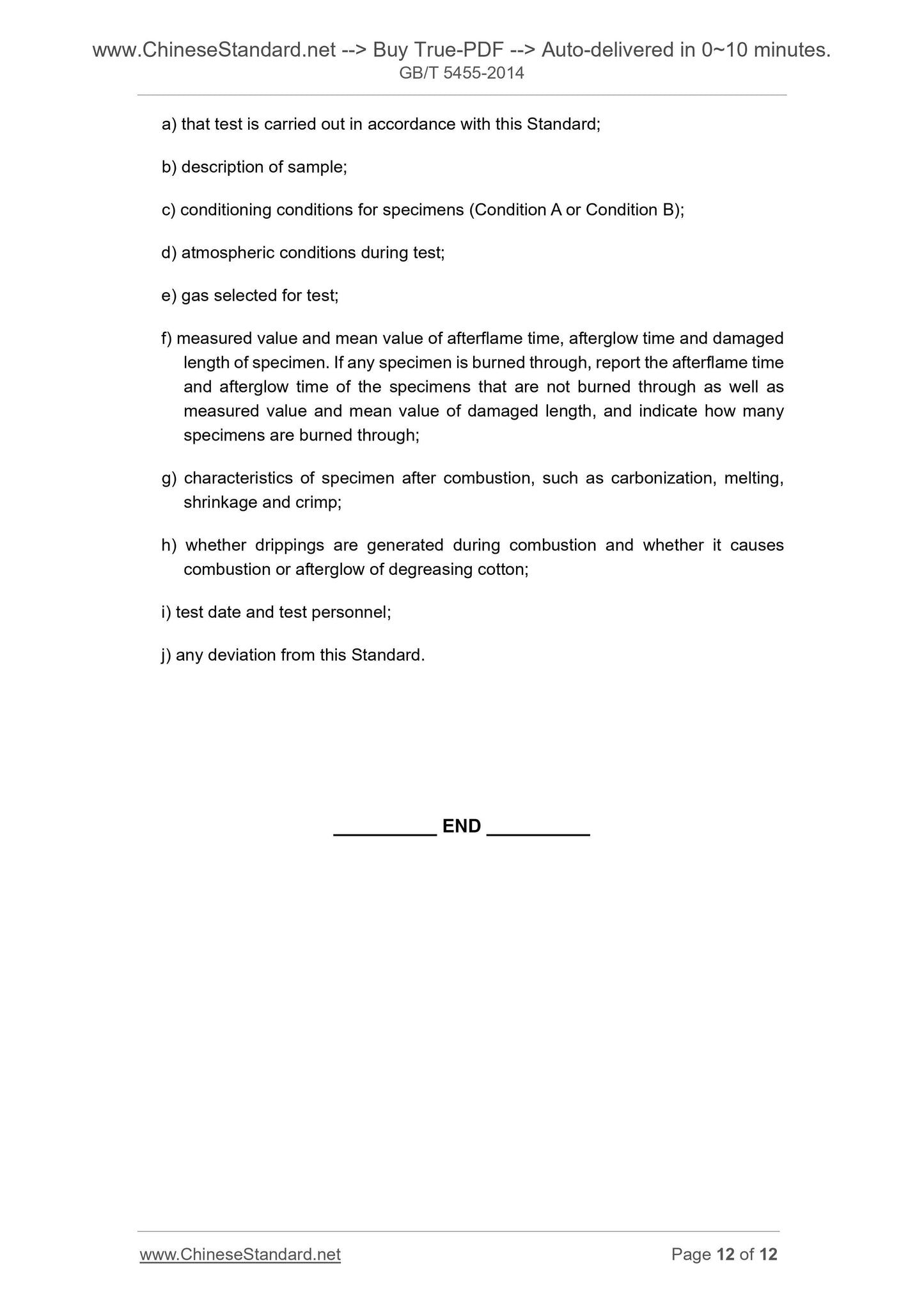1
/
of
6
www.ChineseStandard.us -- Field Test Asia Pte. Ltd.
GB/T 5455-2014 English PDF (GB/T5455-2014)
GB/T 5455-2014 English PDF (GB/T5455-2014)
Regular price
$85.00
Regular price
Sale price
$85.00
Unit price
/
per
Shipping calculated at checkout.
Couldn't load pickup availability
GB/T 5455-2014: Textile - Burning Behaviour - Determination of Damaged Length, Afterglow Time and Afterflame Time of Vertically Oriented Specimens
Delivery: 9 seconds. Download (& Email) true-PDF + Invoice.
Get Quotation: Click GB/T 5455-2014 (Self-service in 1-minute)
Historical versions (Master-website): GB/T 5455-2014
Preview True-PDF (Reload/Scroll-down if blank)
GB/T 5455-2014
GB
NATIONAL STANDARD OF THE
PEOPLE’S REPUBLIC OF CHINA
ICS 59.080.30
W 04
Replacing GB/T 5455-1997
Textile – Burning Behaviour –
Determination of Damaged Length, Afterglow Time and
Afterflame Time of Vertically Oriented Specimens
ISSUED ON. SEPTEMBER 3, 2014
IMPLEMENTED ON. MARCH 1, 2015
Issued by. General Administration of Quality Supervision, Inspection and
Quarantine of the People's Republic of China;
Standardization Administration of the People's Republic of
China.
Table of Contents
Foreword ... 3
1 Application Scope ... 5
2 Normative References ... 5
3 Terms and Definitions ... 5
4 Principle ... 6
5 Health and Safety of Test Personnel ... 6
6 Apparatus and Materials ... 6
7 Specimen Preparation ... 9
8 Test Conditions ... 10
9 Test Procedure ... 10
10 Calculation of Results ... 11
11 Test Report ... 11
Foreword
This Standard was drafted in accordance with the rules given in GB/T 1.1-2009.
This Standard replaces GB/T 5455-1997, Textiles – Burning Behavior – Vertical
Method. Compared with GB/T 5455-1997, the major changes of this Standard are as
follows.
-- the standard name is changed into Textile – Burning Behaviour – Determination
of Damaged Length, Afterglow Time and Afterflame Time of Vertically Oriented
Specimens;
-- it modifies the application scope;
-- it deletes two terms, “afterflame” and “afterglow” and adds the term “flame
application time”;
-- it modifies Figure 1 in the original standard;
-- it adds the diagram of specimen holder (see Figure 2);
-- it deletes the control part of 6.1.5 of the original standard;
-- it modifies the description of “gas” (see 6.1.4);
-- it adds the requirements for the hook of weights (see 6.3);
-- it adds oven and dryer (see 6.6 and 6.7);
-- it modifies the dimensions and number of specimens (see 7.1);
-- it adds one conditioning condition for option (see 7.3);
-- it makes 8.1 “test temperature and humidity” of “test procedure” of the original
standard as an independent article (see Article 8);
-- it reserves the main technical content of Article 8.1 “test procedure”, describes
test procedure once again and adds an optional flame application time;
-- it adds the diagram of “damaged length measurement” (see Figure 4);
-- it adds one method for calculating results (see Article 10).
This Standard was proposed by China National Textile and Apparel Council.
This Standard shall be under the jurisdiction of the Basic Technical Subcommittee of
the National Standardization Technical Committee on Steels (SAC/TC 209/ SC 1).
The drafting organizations of this Standard. Chinatesta Textile (Beijing) Testing and
Textile – Burning Behaviour –
Determination of Damaged Length, Afterglow Time and
Afterflame Time of Vertically Oriented Specimens
1 Application Scope
This Standard specifies the test method for the determination of burning behaviour
when flame is applied to the bottom edge of textile vertically oriented.
This Standard applies to all types of textiles and products.
2 Normative References
The following referenced documents are indispensable for the application of this
document. For dated references, only the edition dated applies to this document. For
undated references, the latest edition of the referenced documents (including all
amendments) applies to this Standard.
GB/T 6529, Textiles – Standard Atmospheres for Conditioning and Testing
3 Terms and Definitions
The following terms and definitions apply to this document.
3.1
afterflame
The time of flame combustion of material after withdrawing ignition source under
specified conditions, expressed in s.
[GB/T 3291.3, Definition 2.145]
3.2
afterglow time
The time of flameless combustion of material under specified test conditions, after
flame combustion terminates or ignition source is withdrawn if it is originally flameless
combustion, expressed in s.
[GB/T 3291.3, Definition 2.146]
specified in GB/T 6529; conditioned specimens are placed into a sealed container.
Condition B. take out specimens after they have been dried in a drying oven for (30 ±
2 min) at (105 ± 3)°C; place into a desiccator for cooling with the time of cooling not
less than 30 min.
NOTE The results tested under Condition A and Condition B are incomparable.
8 Test Conditions
Carry out test in the atmospheric environment of temperature 10°C ~ 30°C and relative
humidity 30% ~ 80%.
9 Test Procedure
9.1 Open gas supply valve before closing the front door of test chamber; light up
igniter; adjust the height of flame to make it stabilize at (40 ± 2) mm. Before starting
the first test, the combustion shall continue stably in this state for 1 min at least and
then the flame is put out.
9.2 Take out specimens from sealed container or desiccator; place on specimen
holder to make specimen as smooth as possible. The bottom side of specimens shall
be aligned with the bottom side of specimen holder. The edge of specimen holder shall
be clamped with a sufficient quantity of clamps. Then clamp the upper end of
specimens mounted to suspend on the support, to make its side face fixed by
specimen holder fixture and specimen holder suspended perpendicularly to the centre
of test chamber.
9.3 Close the chamber door; light up igniter; move the flame to make the bottom side
of specimen just above the centre of the flame after the flame become stabilized; ignite
specimens. At this moment, the time from taking specimens out of sealed container or
desiccator shall be within 1 min.
9.4 The time of applying flame to specimens, i.e. flame application time, is subjected
to the conditioning condition selected (see 7.3). 12 s for Condition A; 3 s for Condition
B.
9.5 After flame application time, withdraw igniter and put out flame; meanwhile, open
timer and record afterflame time and afterglow time, accurate to 0.1 s. If any specimen
is burned through, it shall be recorded.
9.6 When a fabric made of molten fibre is to be tested, degreasing cotton of 10 mm
in thickness shall be used to cover the bottom of test chamber, if molten drops are
generated during the combustion of specimens to be tested. Observe whether the
molten drops cause the combustion or afterglow of degreasing cotton and take records.
a) that test is carried out in accordance with this Standard;
b) description of sample;
c) conditioning conditions for specimens (Condition A or Condition B);
d) atmospheric conditions during test;
e) gas selected for test;
f) measured value and mean value of afterflame time, afterglow time and damaged
length of specimen. If any specimen is burned through, report the afterflame time
and afterglow time of the specimens that are not burned through as well as
measured value and mean value of damaged length, and indicate how many
specimens are burned through;
g) characteristics of specimen after combustion, such as carbonization, melting,
shrinkage and crimp;
h) whether drippings are generated during combustion and whether it causes
combustion or afterglow of degreasing cotton;
i) test date and test personnel;
j) any deviation from this Standard.
GB/T 5455-2014
GB
NATIONAL STANDARD OF THE
PEOPLE’S REPUBLIC OF CHINA
ICS 59.080.30
W 04
Replacing GB/T 5455-1997
Textile – Burning Behaviour –
Determination of Damaged Length, Afterglow Time and
Afterflame Time of Vertically Oriented Specimens
ISSUED ON. SEPTEMBER 3, 2014
IMPLEMENTED ON. MARCH 1, 2015
Issued by. General Administration of Quality Supervision, Inspection and
Quarantine of the People's Republic of China;
Standardization Administration of the People's Republic of
China.
Table of Contents
Foreword ... 3
1 Application Scope ... 5
2 Normative References ... 5
3 Terms and Definitions ... 5
4 Principle ... 6
5 Health and Safety of Test Personnel ... 6
6 Apparatus and Materials ... 6
7 Specimen Preparation ... 9
8 Test Conditions ... 10
9 Test Procedure ... 10
10 Calculation of Results ... 11
11 Test Report ... 11
Foreword
This Standard was drafted in accordance with the rules given in GB/T 1.1-2009.
This Standard replaces GB/T 5455-1997, Textiles – Burning Behavior – Vertical
Method. Compared with GB/T 5455-1997, the major changes of this Standard are as
follows.
-- the standard name is changed into Textile – Burning Behaviour – Determination
of Damaged Length, Afterglow Time and Afterflame Time of Vertically Oriented
Specimens;
-- it modifies the application scope;
-- it deletes two terms, “afterflame” and “afterglow” and adds the term “flame
application time”;
-- it modifies Figure 1 in the original standard;
-- it adds the diagram of specimen holder (see Figure 2);
-- it deletes the control part of 6.1.5 of the original standard;
-- it modifies the description of “gas” (see 6.1.4);
-- it adds the requirements for the hook of weights (see 6.3);
-- it adds oven and dryer (see 6.6 and 6.7);
-- it modifies the dimensions and number of specimens (see 7.1);
-- it adds one conditioning condition for option (see 7.3);
-- it makes 8.1 “test temperature and humidity” of “test procedure” of the original
standard as an independent article (see Article 8);
-- it reserves the main technical content of Article 8.1 “test procedure”, describes
test procedure once again and adds an optional flame application time;
-- it adds the diagram of “damaged length measurement” (see Figure 4);
-- it adds one method for calculating results (see Article 10).
This Standard was proposed by China National Textile and Apparel Council.
This Standard shall be under the jurisdiction of the Basic Technical Subcommittee of
the National Standardization Technical Committee on Steels (SAC/TC 209/ SC 1).
The drafting organizations of this Standard. Chinatesta Textile (Beijing) Testing and
Textile – Burning Behaviour –
Determination of Damaged Length, Afterglow Time and
Afterflame Time of Vertically Oriented Specimens
1 Application Scope
This Standard specifies the test method for the determination of burning behaviour
when flame is applied to the bottom edge of textile vertically oriented.
This Standard applies to all types of textiles and products.
2 Normative References
The following referenced documents are indispensable for the application of this
document. For dated references, only the edition dated applies to this document. For
undated references, the latest edition of the referenced documents (including all
amendments) applies to this Standard.
GB/T 6529, Textiles – Standard Atmospheres for Conditioning and Testing
3 Terms and Definitions
The following terms and definitions apply to this document.
3.1
afterflame
The time of flame combustion of material after withdrawing ignition source under
specified conditions, expressed in s.
[GB/T 3291.3, Definition 2.145]
3.2
afterglow time
The time of flameless combustion of material under specified test conditions, after
flame combustion terminates or ignition source is withdrawn if it is originally flameless
combustion, expressed in s.
[GB/T 3291.3, Definition 2.146]
specified in GB/T 6529; conditioned specimens are placed into a sealed container.
Condition B. take out specimens after they have been dried in a drying oven for (30 ±
2 min) at (105 ± 3)°C; place into a desiccator for cooling with the time of cooling not
less than 30 min.
NOTE The results tested under Condition A and Condition B are incomparable.
8 Test Conditions
Carry out test in the atmospheric environment of temperature 10°C ~ 30°C and relative
humidity 30% ~ 80%.
9 Test Procedure
9.1 Open gas supply valve before closing the front door of test chamber; light up
igniter; adjust the height of flame to make it stabilize at (40 ± 2) mm. Before starting
the first test, the combustion shall continue stably in this state for 1 min at least and
then the flame is put out.
9.2 Take out specimens from sealed container or desiccator; place on specimen
holder to make specimen as smooth as possible. The bottom side of specimens shall
be aligned with the bottom side of specimen holder. The edge of specimen holder shall
be clamped with a sufficient quantity of clamps. Then clamp the upper end of
specimens mounted to suspend on the support, to make its side face fixed by
specimen holder fixture and specimen holder suspended perpendicularly to the centre
of test chamber.
9.3 Close the chamber door; light up igniter; move the flame to make the bottom side
of specimen just above the centre of the flame after the flame become stabilized; ignite
specimens. At this moment, the time from taking specimens out of sealed container or
desiccator shall be within 1 min.
9.4 The time of applying flame to specimens, i.e. flame application time, is subjected
to the conditioning condition selected (see 7.3). 12 s for Condition A; 3 s for Condition
B.
9.5 After flame application time, withdraw igniter and put out flame; meanwhile, open
timer and record afterflame time and afterglow time, accurate to 0.1 s. If any specimen
is burned through, it shall be recorded.
9.6 When a fabric made of molten fibre is to be tested, degreasing cotton of 10 mm
in thickness shall be used to cover the bottom of test chamber, if molten drops are
generated during the combustion of specimens to be tested. Observe whether the
molten drops cause the combustion or afterglow of degreasing cotton and take records.
a) that test is carried out in accordance with this Standard;
b) description of sample;
c) conditioning conditions for specimens (Condition A or Condition B);
d) atmospheric conditions during test;
e) gas selected for test;
f) measured value and mean value of afterflame time, afterglow time and damaged
length of specimen. If any specimen is burned through, report the afterflame time
and afterglow time of the specimens that are not burned through as well as
measured value and mean value of damaged length,...
Delivery: 9 seconds. Download (& Email) true-PDF + Invoice.
Get Quotation: Click GB/T 5455-2014 (Self-service in 1-minute)
Historical versions (Master-website): GB/T 5455-2014
Preview True-PDF (Reload/Scroll-down if blank)
GB/T 5455-2014
GB
NATIONAL STANDARD OF THE
PEOPLE’S REPUBLIC OF CHINA
ICS 59.080.30
W 04
Replacing GB/T 5455-1997
Textile – Burning Behaviour –
Determination of Damaged Length, Afterglow Time and
Afterflame Time of Vertically Oriented Specimens
ISSUED ON. SEPTEMBER 3, 2014
IMPLEMENTED ON. MARCH 1, 2015
Issued by. General Administration of Quality Supervision, Inspection and
Quarantine of the People's Republic of China;
Standardization Administration of the People's Republic of
China.
Table of Contents
Foreword ... 3
1 Application Scope ... 5
2 Normative References ... 5
3 Terms and Definitions ... 5
4 Principle ... 6
5 Health and Safety of Test Personnel ... 6
6 Apparatus and Materials ... 6
7 Specimen Preparation ... 9
8 Test Conditions ... 10
9 Test Procedure ... 10
10 Calculation of Results ... 11
11 Test Report ... 11
Foreword
This Standard was drafted in accordance with the rules given in GB/T 1.1-2009.
This Standard replaces GB/T 5455-1997, Textiles – Burning Behavior – Vertical
Method. Compared with GB/T 5455-1997, the major changes of this Standard are as
follows.
-- the standard name is changed into Textile – Burning Behaviour – Determination
of Damaged Length, Afterglow Time and Afterflame Time of Vertically Oriented
Specimens;
-- it modifies the application scope;
-- it deletes two terms, “afterflame” and “afterglow” and adds the term “flame
application time”;
-- it modifies Figure 1 in the original standard;
-- it adds the diagram of specimen holder (see Figure 2);
-- it deletes the control part of 6.1.5 of the original standard;
-- it modifies the description of “gas” (see 6.1.4);
-- it adds the requirements for the hook of weights (see 6.3);
-- it adds oven and dryer (see 6.6 and 6.7);
-- it modifies the dimensions and number of specimens (see 7.1);
-- it adds one conditioning condition for option (see 7.3);
-- it makes 8.1 “test temperature and humidity” of “test procedure” of the original
standard as an independent article (see Article 8);
-- it reserves the main technical content of Article 8.1 “test procedure”, describes
test procedure once again and adds an optional flame application time;
-- it adds the diagram of “damaged length measurement” (see Figure 4);
-- it adds one method for calculating results (see Article 10).
This Standard was proposed by China National Textile and Apparel Council.
This Standard shall be under the jurisdiction of the Basic Technical Subcommittee of
the National Standardization Technical Committee on Steels (SAC/TC 209/ SC 1).
The drafting organizations of this Standard. Chinatesta Textile (Beijing) Testing and
Textile – Burning Behaviour –
Determination of Damaged Length, Afterglow Time and
Afterflame Time of Vertically Oriented Specimens
1 Application Scope
This Standard specifies the test method for the determination of burning behaviour
when flame is applied to the bottom edge of textile vertically oriented.
This Standard applies to all types of textiles and products.
2 Normative References
The following referenced documents are indispensable for the application of this
document. For dated references, only the edition dated applies to this document. For
undated references, the latest edition of the referenced documents (including all
amendments) applies to this Standard.
GB/T 6529, Textiles – Standard Atmospheres for Conditioning and Testing
3 Terms and Definitions
The following terms and definitions apply to this document.
3.1
afterflame
The time of flame combustion of material after withdrawing ignition source under
specified conditions, expressed in s.
[GB/T 3291.3, Definition 2.145]
3.2
afterglow time
The time of flameless combustion of material under specified test conditions, after
flame combustion terminates or ignition source is withdrawn if it is originally flameless
combustion, expressed in s.
[GB/T 3291.3, Definition 2.146]
specified in GB/T 6529; conditioned specimens are placed into a sealed container.
Condition B. take out specimens after they have been dried in a drying oven for (30 ±
2 min) at (105 ± 3)°C; place into a desiccator for cooling with the time of cooling not
less than 30 min.
NOTE The results tested under Condition A and Condition B are incomparable.
8 Test Conditions
Carry out test in the atmospheric environment of temperature 10°C ~ 30°C and relative
humidity 30% ~ 80%.
9 Test Procedure
9.1 Open gas supply valve before closing the front door of test chamber; light up
igniter; adjust the height of flame to make it stabilize at (40 ± 2) mm. Before starting
the first test, the combustion shall continue stably in this state for 1 min at least and
then the flame is put out.
9.2 Take out specimens from sealed container or desiccator; place on specimen
holder to make specimen as smooth as possible. The bottom side of specimens shall
be aligned with the bottom side of specimen holder. The edge of specimen holder shall
be clamped with a sufficient quantity of clamps. Then clamp the upper end of
specimens mounted to suspend on the support, to make its side face fixed by
specimen holder fixture and specimen holder suspended perpendicularly to the centre
of test chamber.
9.3 Close the chamber door; light up igniter; move the flame to make the bottom side
of specimen just above the centre of the flame after the flame become stabilized; ignite
specimens. At this moment, the time from taking specimens out of sealed container or
desiccator shall be within 1 min.
9.4 The time of applying flame to specimens, i.e. flame application time, is subjected
to the conditioning condition selected (see 7.3). 12 s for Condition A; 3 s for Condition
B.
9.5 After flame application time, withdraw igniter and put out flame; meanwhile, open
timer and record afterflame time and afterglow time, accurate to 0.1 s. If any specimen
is burned through, it shall be recorded.
9.6 When a fabric made of molten fibre is to be tested, degreasing cotton of 10 mm
in thickness shall be used to cover the bottom of test chamber, if molten drops are
generated during the combustion of specimens to be tested. Observe whether the
molten drops cause the combustion or afterglow of degreasing cotton and take records.
a) that test is carried out in accordance with this Standard;
b) description of sample;
c) conditioning conditions for specimens (Condition A or Condition B);
d) atmospheric conditions during test;
e) gas selected for test;
f) measured value and mean value of afterflame time, afterglow time and damaged
length of specimen. If any specimen is burned through, report the afterflame time
and afterglow time of the specimens that are not burned through as well as
measured value and mean value of damaged length, and indicate how many
specimens are burned through;
g) characteristics of specimen after combustion, such as carbonization, melting,
shrinkage and crimp;
h) whether drippings are generated during combustion and whether it causes
combustion or afterglow of degreasing cotton;
i) test date and test personnel;
j) any deviation from this Standard.
GB/T 5455-2014
GB
NATIONAL STANDARD OF THE
PEOPLE’S REPUBLIC OF CHINA
ICS 59.080.30
W 04
Replacing GB/T 5455-1997
Textile – Burning Behaviour –
Determination of Damaged Length, Afterglow Time and
Afterflame Time of Vertically Oriented Specimens
ISSUED ON. SEPTEMBER 3, 2014
IMPLEMENTED ON. MARCH 1, 2015
Issued by. General Administration of Quality Supervision, Inspection and
Quarantine of the People's Republic of China;
Standardization Administration of the People's Republic of
China.
Table of Contents
Foreword ... 3
1 Application Scope ... 5
2 Normative References ... 5
3 Terms and Definitions ... 5
4 Principle ... 6
5 Health and Safety of Test Personnel ... 6
6 Apparatus and Materials ... 6
7 Specimen Preparation ... 9
8 Test Conditions ... 10
9 Test Procedure ... 10
10 Calculation of Results ... 11
11 Test Report ... 11
Foreword
This Standard was drafted in accordance with the rules given in GB/T 1.1-2009.
This Standard replaces GB/T 5455-1997, Textiles – Burning Behavior – Vertical
Method. Compared with GB/T 5455-1997, the major changes of this Standard are as
follows.
-- the standard name is changed into Textile – Burning Behaviour – Determination
of Damaged Length, Afterglow Time and Afterflame Time of Vertically Oriented
Specimens;
-- it modifies the application scope;
-- it deletes two terms, “afterflame” and “afterglow” and adds the term “flame
application time”;
-- it modifies Figure 1 in the original standard;
-- it adds the diagram of specimen holder (see Figure 2);
-- it deletes the control part of 6.1.5 of the original standard;
-- it modifies the description of “gas” (see 6.1.4);
-- it adds the requirements for the hook of weights (see 6.3);
-- it adds oven and dryer (see 6.6 and 6.7);
-- it modifies the dimensions and number of specimens (see 7.1);
-- it adds one conditioning condition for option (see 7.3);
-- it makes 8.1 “test temperature and humidity” of “test procedure” of the original
standard as an independent article (see Article 8);
-- it reserves the main technical content of Article 8.1 “test procedure”, describes
test procedure once again and adds an optional flame application time;
-- it adds the diagram of “damaged length measurement” (see Figure 4);
-- it adds one method for calculating results (see Article 10).
This Standard was proposed by China National Textile and Apparel Council.
This Standard shall be under the jurisdiction of the Basic Technical Subcommittee of
the National Standardization Technical Committee on Steels (SAC/TC 209/ SC 1).
The drafting organizations of this Standard. Chinatesta Textile (Beijing) Testing and
Textile – Burning Behaviour –
Determination of Damaged Length, Afterglow Time and
Afterflame Time of Vertically Oriented Specimens
1 Application Scope
This Standard specifies the test method for the determination of burning behaviour
when flame is applied to the bottom edge of textile vertically oriented.
This Standard applies to all types of textiles and products.
2 Normative References
The following referenced documents are indispensable for the application of this
document. For dated references, only the edition dated applies to this document. For
undated references, the latest edition of the referenced documents (including all
amendments) applies to this Standard.
GB/T 6529, Textiles – Standard Atmospheres for Conditioning and Testing
3 Terms and Definitions
The following terms and definitions apply to this document.
3.1
afterflame
The time of flame combustion of material after withdrawing ignition source under
specified conditions, expressed in s.
[GB/T 3291.3, Definition 2.145]
3.2
afterglow time
The time of flameless combustion of material under specified test conditions, after
flame combustion terminates or ignition source is withdrawn if it is originally flameless
combustion, expressed in s.
[GB/T 3291.3, Definition 2.146]
specified in GB/T 6529; conditioned specimens are placed into a sealed container.
Condition B. take out specimens after they have been dried in a drying oven for (30 ±
2 min) at (105 ± 3)°C; place into a desiccator for cooling with the time of cooling not
less than 30 min.
NOTE The results tested under Condition A and Condition B are incomparable.
8 Test Conditions
Carry out test in the atmospheric environment of temperature 10°C ~ 30°C and relative
humidity 30% ~ 80%.
9 Test Procedure
9.1 Open gas supply valve before closing the front door of test chamber; light up
igniter; adjust the height of flame to make it stabilize at (40 ± 2) mm. Before starting
the first test, the combustion shall continue stably in this state for 1 min at least and
then the flame is put out.
9.2 Take out specimens from sealed container or desiccator; place on specimen
holder to make specimen as smooth as possible. The bottom side of specimens shall
be aligned with the bottom side of specimen holder. The edge of specimen holder shall
be clamped with a sufficient quantity of clamps. Then clamp the upper end of
specimens mounted to suspend on the support, to make its side face fixed by
specimen holder fixture and specimen holder suspended perpendicularly to the centre
of test chamber.
9.3 Close the chamber door; light up igniter; move the flame to make the bottom side
of specimen just above the centre of the flame after the flame become stabilized; ignite
specimens. At this moment, the time from taking specimens out of sealed container or
desiccator shall be within 1 min.
9.4 The time of applying flame to specimens, i.e. flame application time, is subjected
to the conditioning condition selected (see 7.3). 12 s for Condition A; 3 s for Condition
B.
9.5 After flame application time, withdraw igniter and put out flame; meanwhile, open
timer and record afterflame time and afterglow time, accurate to 0.1 s. If any specimen
is burned through, it shall be recorded.
9.6 When a fabric made of molten fibre is to be tested, degreasing cotton of 10 mm
in thickness shall be used to cover the bottom of test chamber, if molten drops are
generated during the combustion of specimens to be tested. Observe whether the
molten drops cause the combustion or afterglow of degreasing cotton and take records.
a) that test is carried out in accordance with this Standard;
b) description of sample;
c) conditioning conditions for specimens (Condition A or Condition B);
d) atmospheric conditions during test;
e) gas selected for test;
f) measured value and mean value of afterflame time, afterglow time and damaged
length of specimen. If any specimen is burned through, report the afterflame time
and afterglow time of the specimens that are not burned through as well as
measured value and mean value of damaged length,...
Share
